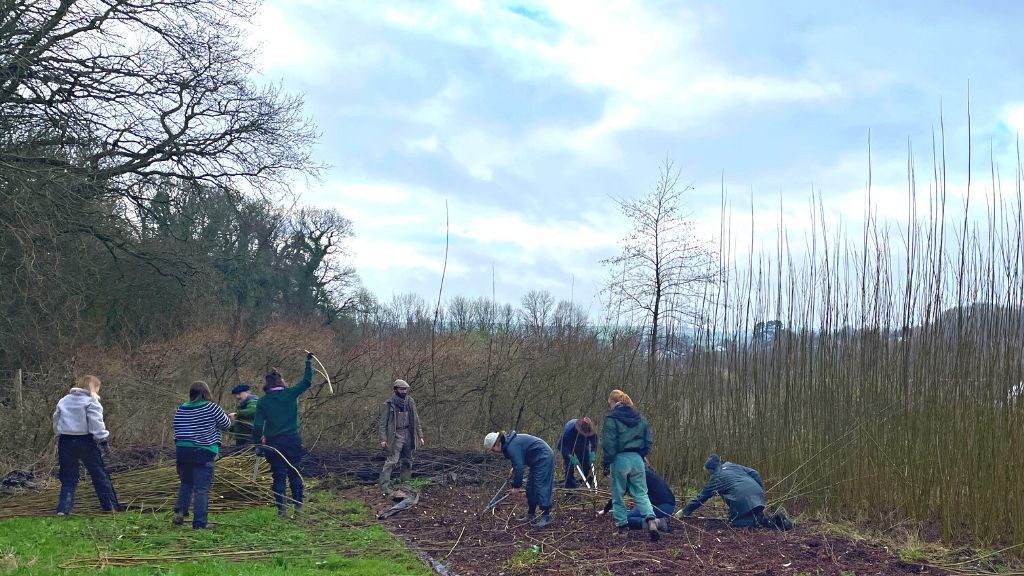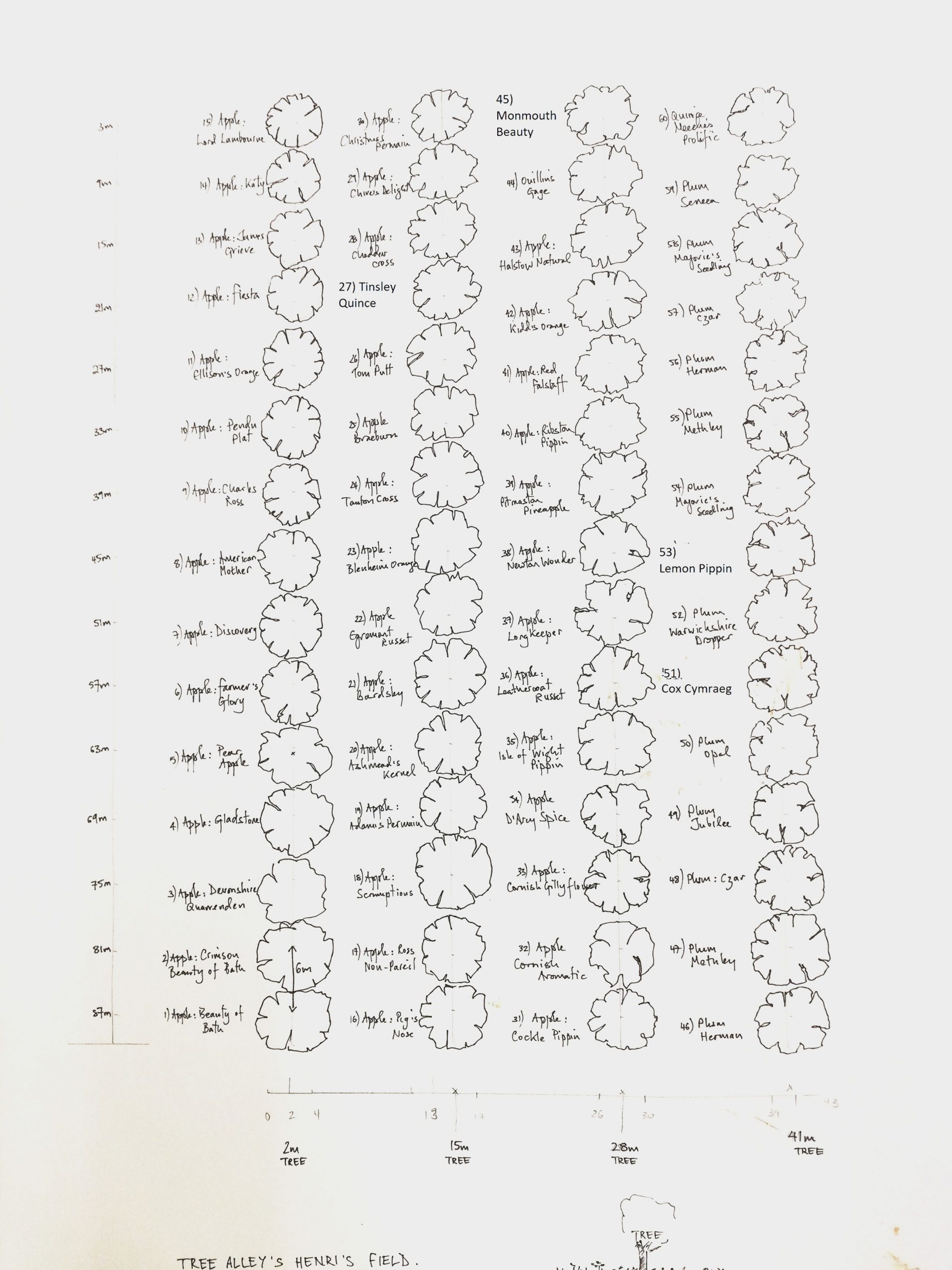
This 5 acre field lies at the heart of Schumacher College providing fresh, organically grown fruit, vegetables and flowers for our learning community and the wider estate. It is also our most abundant and diverse outdoor classroom providing students and visitors alike with a beautiful, biodiverse and educational space to study.
Named for physicist Henri Bortoft who taught postgraduate classes at Schumacher College, the field is an exemplar of a radical alternative to the conventional farming system.
Designed and nurtured by the team that run our Practical Residency in Agroecology, the field was taken on by the College in 2015. Previously grazing pasture for a herd of dairy cows, the land was given a Permaculture redesign by then Head Gardener Jane Gleeson. Native hedgerows were soon planted for windbreak, habitat creation and pollinators. Apple, plum and cherry trees were planted in alleys in-between annual vegetable beds in the agroforestry technique. Sweet chestnuts, hazels and willow coppices were planted. The initial trees and hedges of a forest garden were laid out, and a circular flower garden design began to form.

Now, years later, much of this initial eco-infrastructure is coming to maturity, with an abundance of fruits, nuts, vegetables and wood being harvested from the field.
Insects, birds and animals have also been thriving since the field was transformed. With two wildlife ponds and a wide variety of different habitats, plant species and food sources, we have noticed an increase in biodiversity. Regular visitors to Henri’s Field include kestrels, buzzards, owls, a resident heron (called Harry), grass snakes, toads, newts, frogs, mice, voles, moles, foxes, many types of songbirds, wood pigeons, hedgehogs, bees, butterflies, moths, spiders, grasshoppers and more!
What can be found in the field?

A wide range of annual vegetables, salads, grains, fibre and food crops growing seasonally in minimum tillage market garden beds.

Organic and ecologically sustainable agriculture techniques such as intercropping, crop rotation and companion planting.

Examples of agroforestry techniques including silvopasture chicken run, silvoarable alley cropping with fruit trees and currant bushes, an edible food forest and edible hedgerows.
Photo credit: Sam Chevallier
Apple, plum and cherry tree rows planted in agroforestry alleys between annual vegetable beds with a wide range of benefits including:
– increasing biodiversity
– accessing a greater range of nutrients via deep tree roots mining the soil to deeper depths
– increased yield in a given area due to farming crops at ground and canopy level simultaneously
– flowers and fruit encourage beneficial insects and birds who prey on pest insects
– improved soil health as banks of perennials in-between annual beds can keep a reserve of mycorrhizal fungi and healthy
– soil life constant, even when the soil in annual beds is being regularly disturbed through cultivation. Allowing essential
– mineral and nutrient exchange between soil life and plants.

Forest Garden featuring a wide variety of unusual edible perennials ranging from fruit, nuts, tubers, leaves, vegetables and flowers.

Seed Saving Plot where students grow a range of vegetables, grains and flowers for a harvestable seed crop. An important part of our fight for greater seed sovereignty and self-sufficiency.

Wild areas for nature including hedgerows, meadow, nettles, brambles, log piles and wildlife ponds.

Craft & Cut Flower Garden with annual and perennial flowers, plants for natural dyeing and crafting materials like basketry willow.

Polytunnels for covered cropping of Mediterranean veg such as tomatoes, chillies and aubergines. Also a space that keeps us self-sufficient in fresh greens and salads through the winter months. We use the polytunnels to experiment with fun heat loving crops like cape gooseberry, luffa and even cotton!

Our own nestled business The Mother Tree, a fruit, nut and forest garden tree nursery specialising in heritage apple varieties.

Natural bee hives for wild bee colonies and pollination benefits, not for honey harvest.

Coppices of hazel, biomass willow and basketry willow. Mostly for chipping up and using to enhance our on-farm fertility via the ramial woodchip technique.

Experimental grain and fibre crops. We grow a yearly crop of flax for fibre processing into linen, a small amount of YQ population wheat, and grains exploring global food systems and different food cultures such as amaranth for quinoa.

Green manures for on-farm fertility. We include several uses of cover crops or “green manures” in our system to build soil health and reduce our need to bring in compost or manure from outside of our system.

Hedges for foraging, windbreak and stock-proofing. Our hedges include native mixes of trees, shrubs, hedge plants and fruiting species such as cherry plum and heritage apple trees. Our hedges are laid when mature enough in a traditional way that restores the hedgerow and keeps it healthy for years to come.

Our apple trees provide a bounty of apples which we press each autumn into juice. We host a community event celebrating all things apple and showcasing our heritage varieties grown in the field.
Photo credit: Josh Pratt

Space for celebration, ritual and ceremony. We dedicate time in our busy gardening schedules to pay tribute to nature and the bounty of food produced in Henri’s Field. Our favourite event of the year is Harvest Festival when the students of the Practical Residency in Agroecology (or The Growers as we fondly know them) harvest, cook and serve a delicious meal all from produce we grow in Henri’s Field. We cook the food over open fires in the field and serve it there amongst the flowers and trees to the rest of the college. Photo credit: Josh Pratt
Courses and degrees
All students at Dartington are invited to engage with the communal effort of growing food to sustain ourselves throughout the year. There are weekly community sessions where our growers facilitate practical tasks in which everyone can get involved. Use the buttons below to explore the three main courses working most directly in the context of Henri’s Field throughout the year.
Lead image credit: Sam Chevallier

